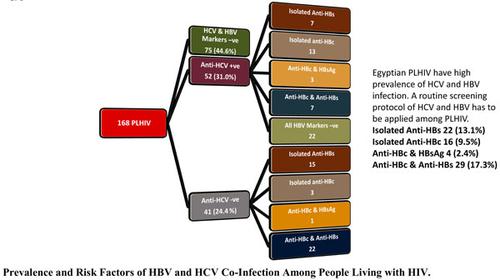Current HIV Research ( IF 1 ) Pub Date : 2021-11-30 , DOI: 10.2174/1570162x19666210805095712 Engy Mohamed El-Ghitany 1 , Azza Galal Farghaly 1 , Yasmine Mohammed Alkassabany 1

|
Background: Human Immune Deficiency Virus (HIV), Hepatitis B Virus (HBV) and Hepatitis C Virus (HCV) infections constitute a global health concern. They share common modes of transmission, increasing the likelihood of co-infection. Co-infection accelerates viral replication, promotes the progression of chronic liver diseases and challenges antiviral therapy. There are no available data addressing the magnitude of chronic viral hepatitis co-infection in people living with HIV in Egypt. Nor is there a mandate for HCV/HBV screening. This cross-sectional study provides needed data on HBV and/or HCV co-infection in Egyptian people living with HIV.
Subjects and Methods: The study was conducted at the HIV clinic in Alexandria Fever Hospital. The investigation included 168 confirmed HIV cases. All cases were interviewed and tested for HCV-Ab and HBsAg by ELISA.
Results: There were 52 (31%) persons who were anti-HCV positive. 40 of them had detectable HCV RNA (76.9%). HIV/HCV co-infection was significantly higher among males (40.7%) compared to only (10.9%) among females (OR = 3). History of imprisonment (OR = 4.84, CI: 1.33-17.62), accidental puncture with protruding needle contaminated with blood (OR = 3.35, CI: 0.99-11.72), alcohol use (OR = 3.03, CI: 1.13-8.09) and male gender (OR = 2.96, CI: 0.99-8.88) were all significant predictors for HIV/HCV co-infection. On the other hand, HIV/HCV co-infection was inversely associated with high education level (OR = 0.28, CI: 0.10-0.76). HBsAg was detected in 4 (2.4%), and anti-HBc in 49 (29.2%) of HIV patients. Previous HBV infection (positive anti-HBc/negative anti-HBs) was significantly associated with a history of female genital mutilation circumcision, injection drug use, invasive procedures, non-specific fatigue and HCV-Ab seropositivity.
Conclusion: Egyptian people living with HIV have an increased frequency of HCV antibody and HCV infection compared to the general population indicating a higher risk of infection and suggest a higher risk of HCV exposure. Past or present HBV co-infections are also elevated. Routine screening of these viruses in the management protocol of people living with HIV in Egypt is recommended.
中文翻译:

在埃及环境中 HIV 感染者中 HBV 和 HCV 合并感染的流行率和危险因素
背景:人类免疫缺陷病毒 (HIV)、乙型肝炎病毒 (HBV) 和丙型肝炎病毒 (HCV) 感染构成全球健康问题。它们具有共同的传播方式,增加了共同感染的可能性。合并感染会加速病毒复制,促进慢性肝病的进展并挑战抗病毒治疗。没有关于埃及艾滋病毒感染者慢性病毒性肝炎合并感染程度的可用数据。也没有要求进行 HCV/HBV 筛查。这项横断面研究提供了埃及 HIV 感染者中 HBV 和/或 HCV 合并感染所需的数据。
对象和方法:该研究在亚历山大热病医院的 HIV 诊所进行。调查包括 168 例确诊的艾滋病毒病例。对所有病例进行了访谈,并通过 ELISA 检测了 HCV-Ab 和 HBsAg。
结果:有 52 人 (31%) 人抗 HCV 呈阳性。其中 40 人可检测到 HCV RNA(76.9%)。男性(40.7%)的 HIV/HCV 合并感染率显着高于女性(10.9%)(OR = 3)。入狱史(OR = 4.84,CI:1.33-17.62),被血液污染的突出针意外穿刺(OR = 3.35,CI:0.99-11.72),饮酒(OR = 3.03,CI:1.13-8.09)和男性性别(OR = 2.96,CI:0.99-8.88)都是 HIV/HCV 合并感染的重要预测因子。另一方面,HIV/HCV 合并感染与受教育程度呈负相关(OR = 0.28,CI:0.10-0.76)。4 名 (2.4%) 的 HIV 患者检测到 HBsAg,49 名 (29.2%) 的 HIV 患者检测到抗 HBc。既往 HBV 感染(抗 HBc 阳性/抗 HBs 阴性)与女性生殖器割礼史显着相关,
结论:与普通人群相比,埃及 HIV 感染者的 HCV 抗体和 HCV 感染频率增加,表明感染风险更高,提示 HCV 暴露风险更高。过去或现在的 HBV 合并感染也有所增加。建议在埃及艾滋病病毒感染者的管理方案中对这些病毒进行常规筛查。


























 京公网安备 11010802027423号
京公网安备 11010802027423号